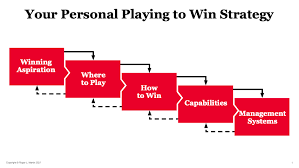This white paper aims to expand upon the concepts presented in "Playing to Win: How Strategy Really Works," providing a more comprehensive exploration of strategic thinking and its application in various business contexts. It will draw upon insights from the recommended book list to offer a deeper understanding of the key elements of effective strategy.
Book List: Expanding on "Playing to Win: How Strategy Really Works"
Core Text
- Playing to Win: How Strategy Really Works by A.G. Lafley and Roger L. Martin
Complementary Readings
- Good Strategy/Bad Strategy: The Difference and Why It Matters by Richard P. Rumelt
- Competitive Strategy: Techniques for Analyzing Industries and Competitors by Michael E. Porter
- Blue Ocean Strategy: How to Create Uncontested Market Space and Make the Competition Irrelevant by W. Chan Kim and Renée Mauborgne
- The Art of Strategy: A Game Theorist's Guide to Success in Business and Life by Avinash K. Dixit and Barry J. Nalebuff
- The Innovator's Dilemma: When New Technologies Cause Great Firms to Fail by Clayton M. Christensen
- The Innovator's Solution: Creating and Sustaining Successful Growth by Clayton M. Christensen, Michael E. Raynor, and Rory McDonald
- Rethinking Strategy: A New Way to See the World and the Future of Your Company by Michael E. Porter
Additional Resources
- Harvard Business Review for articles on strategy, leadership, and innovation.
- McKinsey Quarterly for in-depth analysis of business trends and strategies.
- The Economist for global business news and analysis.
Expanded White Paper: A Deeper Dive into Strategic Thinking
Introduction
This white paper aims to expand upon the concepts presented in "Playing to Win: How Strategy Really Works," providing a more comprehensive exploration of strategic thinking and its application in various business contexts. It will draw upon insights from the recommended book list to offer a deeper understanding of the key elements of effective strategy.
Key Themes and Concepts
- Strategic Clarity: The importance of defining a clear and compelling strategic intent, aligning the organization's efforts toward a shared vision.
- Customer Focus: The centrality of understanding and meeting customer needs as the foundation of a successful strategy.
- Competitive Advantage: The development of unique capabilities and resources that differentiate a company from its competitors.
- Innovation: The continuous pursuit of new ideas and approaches to drive growth and stay ahead of market trends.
- Leadership: The role of strong leadership in shaping and implementing a successful strategy, inspiring and motivating employees.
- Execution: The importance of effective execution to translate strategic plans into tangible results.
Case Studies
- Analyzing real-world examples of companies that have successfully implemented strategic thinking to achieve sustainable competitive advantage.
- Examining both successes and failures to identify key lessons learned and best practices.
Emerging Trends and Future Implications
- Exploring the impact of digital disruption, globalization, and other emerging trends on strategic thinking and business models.
- Discussing the potential implications of artificial intelligence, automation, and other technological advancements for strategy development and execution.
Conclusion
- Summarizing the key takeaways from the expanded exploration of strategic thinking.
- Emphasizing the importance of ongoing learning and adaptation in a rapidly changing business environment.
Reference List
- Lafley, A.G., & Martin, R.L. (2013). Playing to win: How strategy really works. Harvard Business Review Press.
- Rumelt, R.P. (2011). Good strategy/bad strategy: The difference and why it matters.
- Porter, M.E. (1980). Competitive strategy: Techniques for analyzing industries and competitors. Free Press.
- Kim, W.C., & Mauborgne, R. (2005). Blue ocean strategy: How to create uncontested market space and make the competition irrelevant. Harvard Business School Press.
- Dixit, A.K., & Nalebuff, B.J. (1991). The art of strategy: A game theorist's guide to success in business and life. W.W. Norton & Company.
- Christensen, C.M. (1997). The innovator's dilemma: When new technologies cause great firms to fail. Harvard Business School Press.
- Christensen, C.M., Raynor, M.E., & McDonald, R. (2003). The innovator's solution: Creating and sustaining successful growth. Harvard Business School Press.
- Porter, M.E. (2013). Rethinking strategy: A new way to see the world and the future of your company. Harvard Business Review Press.
Note: This is a preliminary outline and can be further expanded upon based on specific research and analysis. Contact keencmputer.com for details.
